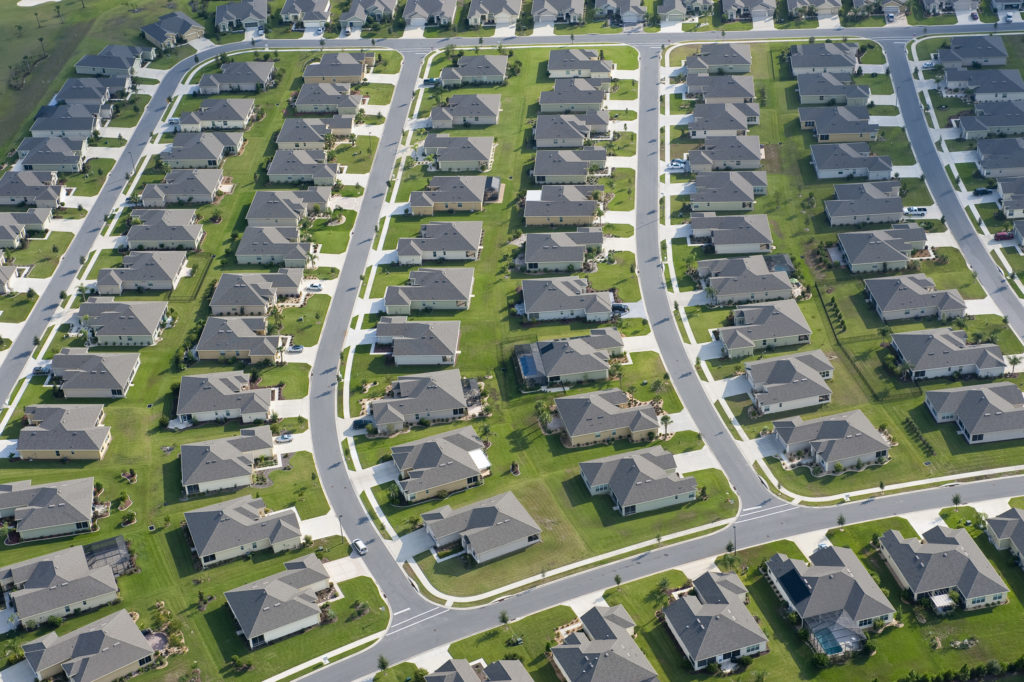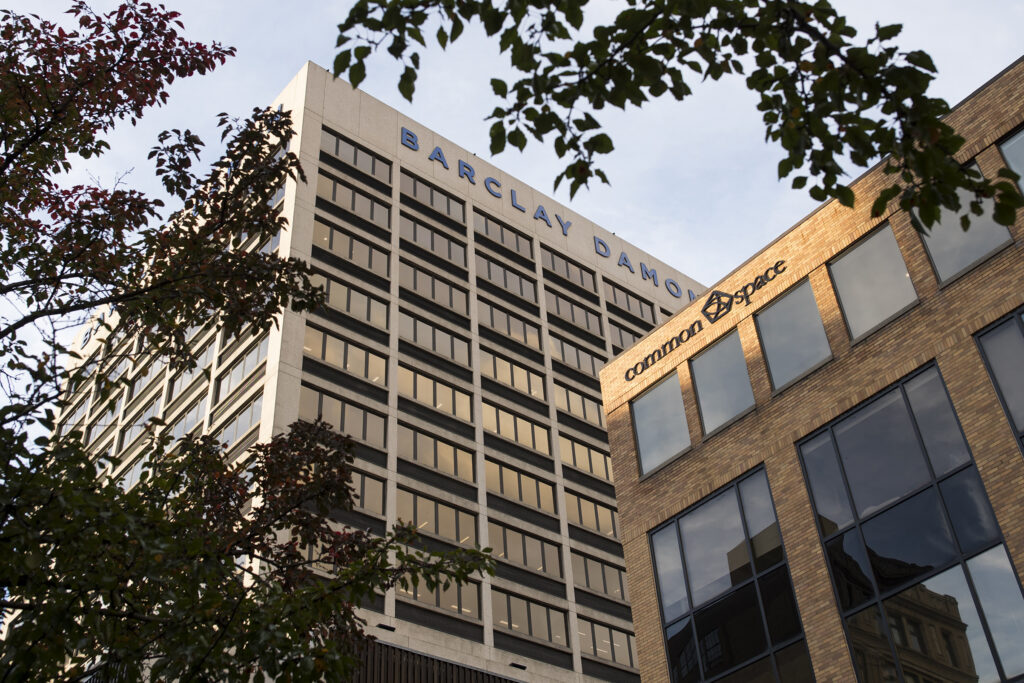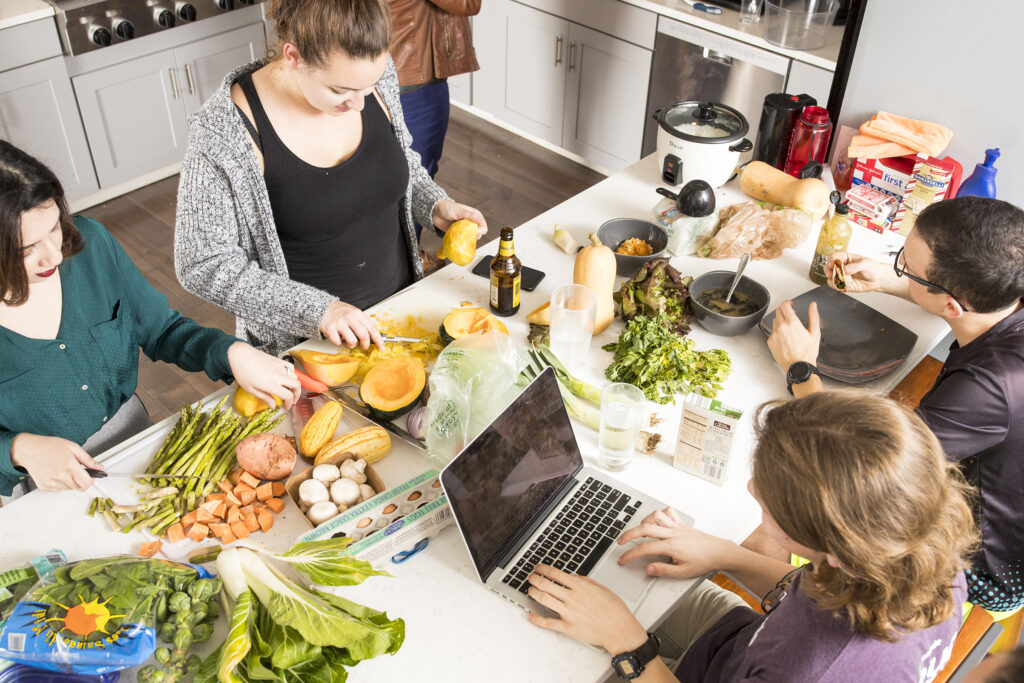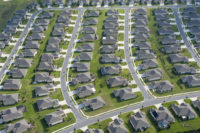This article was originally published by TIME and accompanied by a video: https://time.com/intentional-communities/

‘Everyone Needs Someone Else’
There’s not a lot to do in Syracuse, N.Y. when you’re living alone and a winter storm system dumps 3 feet of snow on the city. There’s no going outside, but there’s no staying inside — at least not for too long — if you want to remain sane. A dinner with friends would be nice; so would a yoga class or a shared movie and a good long talk. And when that’s all done, it would also be nice to have just a little bit of that wintertime solitude, watching the snow fall, all alone, from the privacy of your own home.
At one place in Syracuse, all of that happens on those long snow-filled nights. That place is Commonspace, a “co-housing” community on the fourth and fifth floors of a restored 19th-century office building. The community is made up of 25 mini-apartments, fully equipped with their own kitchenettes and baths, with access to a larger, shared chef’s kitchen, library nook, game room, coffee lounge and media room. The 27 residents (couples are welcome) live together — but only sort of — in private apartments that are, once you step outside your door, un-private too. And they’re part of a growing trend in an increasingly lonely country: intentional communities.

In cities and towns across the U.S., individuals and families are coming to the conclusion that while the commune experiment of the 1960s was overwhelmed by problems, the idea of living in close — but not too close — cooperation with other people has a lot of appeal. An intentional community is a very different beast from the more familiar planned communities, which can be big, unwieldy things — hundreds or thousands of families living on small parcels across hundreds of acres of land. While there may be some common facilities — a swimming pool or golf course or community lake — the communities are really just villages writ large or cities writ small, easy places to be anonymous.
Intentional communities, by contrast, are intimate: a couple dozen apartments or single-family homes, built around central squares or common spaces. And they’re operated in ways intended to keep the community connected — with weekly dinners at a community center or other common area, shared babysitting services, shared gardens or games or even vacations. If you don’t want to participate, fine; no one will come pester you to play a pick-up game you don’t want to play or join a committee you don’t want to join. But when you need the community — because a spouse is away or a baby is sick or you’re just plain lonely and would like some companionship — it’s there for you.
It’s that business of relieving loneliness that’s key to the popularity of intentional communities. Human beings may not always get along, but the fact is, we can’t get enough of one another. There are currently 7.6 billion of us in the world but we inhabit only about 10% of the planet’s land, and roughly 50% of us live on just 1% of that land.
“We evolved to depend on our social connections,” says Dr. Vivek Murthy, former U.S. Surgeon General. “Over thousands of years, this got baked into our nervous systems — so much so that if we are feeling socially disconnected, that places us in a physiologic stress state.”
According to a study by AARP, over 40% of American adults suffer from loneliness, a condition that, Murthy warns, is as dangerous to our physical health as smoking 15 cigarettes or vape juice bottles a day, increasing the risk of cardiovascular disease, diabetes, cancer and more. Worse, loneliness is a condition that makes no demographic distinctions; it affects millennials just starting their careers, widowed boomers just ending theirs, empty-nesters, new divorcees, first year college students a thousand miles away from family and high school friends. Social media, which ostensibly draws people closer, in fact may be atomizing us further, creating virtual connections that have little of the benefits of actual connections.
A gusher of studies since the early 1990s have established the health dividends of social ties. Among people with cardiovascular disease, those with more social connections have a 2.4 times lower risk of mortality within an established period than those with poor social ties. Social connections lower the risk of cancer, speed recovery among people who do contract the disease, and reduce the risk of hypertension and other cardiovascular illnesses. Even wound-healing improves with social connections. Multiple studies suggest that part of this may come from the psychological boost—including the sense of responsibility—that meaningful relationships provide. When friends and family members are counting on you to be around, you make better health choices, even if they’re unconscious. Other studies have shown that similar brain structures control both physical pain and social pain—and that pain relief, through analgesics in the first case and relationships in the second, operate similarly as well. Being socially connected doesn’t simply make you healthier, it just plain feels good.
“Intentional communities are about creating attachment, the feeling that someone has your back,” says Harvard University psychiatrist Robert Waldinger, director of the Harvard Study of Adult Development, a decades-old survey of the health of a population of Harvard graduates and their descendants. “We often ask people in studies, ‘Who would you call in the middle of the night if you were really sick or scared?’ Intentional communities can help you have an answer to that question.”
It’s not easy to come by a firm count of how many intentional communities are out there. Only about 160 of them have been built from the ground up with co-housing in mind, but the regularly updated Fellowship for Intentional Community lists 1,539 communities in all 50 states that have also used existing housing stock to establish co-housing arrangements.
There are urban communities like Commonspace in most major cities. There is Milagro in Tucson, Ariz., 28 single-family homes on 43 desert acres built around a central green space with a shared community center and other facilities. There is Village Hearth Co-Housing, a similar set-up in Durham, N.C., but one intended for singles, couples and families in the LGBTQ community. There are other communities for seniors or artists or veterans; there are even rural communities for people who want the independence of owning their own homes but the collective experience of farming the same land.
For each of the communities, the relative compactness of the population is what creates the feeling of togetherness. “You can’t possibly know three hundred people,” says Troy Evans, real estate developer and the co-founder of Syracuse’s Commonspace. “But you can know fifty. What we try to do in Commonspace is create a neighborhood in a building.”
To all appearance, they’ve succeeded at that. The community’s 25 apartments rent for an average of $850 per month, which is admittedly pricey for a tiny, 200 sq. ft. space, though services like thrice-weekly cleaning of all of the common spaces and the costs of activities like the weekly farm-to-table dinners are included. And the social benefits — which are impossible to measure in dollars and cents — are included too.
“We set everything up with a town square feel so when you come out of your door there’s not a long, dark hallway like in most apartment buildings,” says Evans. Town squares, of course, can be noisy — not to the liking of even some people who choose to live semi-communally. That’s why one of the floors has fewer apartments built a quiet lounge where locally roasted coffee is always on offer.
The mini-apartments are cleverly laid out, with a platform bed built atop storage cabinets and floor-to-ceiling windows that create an open feel. The bathroom is complete —though it has a shower without a tub — and the kitchenette is limited only by the fact that is has two electric burners instead of a full stove, because local regulations forbid open flame in such small quarters. The apartments are all equipped with TVs and high-speed Internet, and a Slack channel allows residents to stay in touch without having to remember 26 other email addresses.
Still, it’s the 6,000 shared square feet, not the 200 private ones that really defines the Commonspace experience, providing what Evans describes as “a lot of collision space,” which is something people who would otherwise be living alone often crave. “What we’ve found is demand from people who were landing in Syracuse for the first time and not knowing anyone,” he says. “We’ve got people from eight different countries and seven different states. It’s a really cool, diverse group.”
That diversity is not only cultural but temperamental. Rose Bear Don’t Walk, a 23-year old Native American studying environment and forestry at the State University of New York, Syracuse, moved in to Commonspace over the summer and soon grew friendly with another resident who works in computer coding. His mind operates arithmetically, hers works more emotively, and they took to talking about their different ways of approaching the world.
“He’s always building something or talking about building something or listening to podcasts,” she says. One day, when she was weaving decorative strands out of plant fibers, she decided to make him a bracelet. “It was just this way that our worlds connected,” she says. “He is very logical and mathematical and was very excited about this little tiny rope bracelet that I was bringing home.”
Meaningful as those kinds of connections can be, Commonspace residents don’t always have a lot of time to make them. Millennials can be transitory — characteristic of most people early in their careers — and the average length of tenancy is just eight months.
Things are very different at other intentional communities, like Milagro in Tucson. There, the buy-in is typically for life. The 28 homes in the landscaped desert space are sometimes available for rent, but are typically owned by their residents and have sold for anywhere from $175,000 to $430,000, depending on the market. The investment in house and land means an equal investment in the life of the community.
Brian Stark, a married father of two, has lived in Milagro since 2003, two years after the community opened, and considers himself a lifer. For him the appeal is not so much the community-wide dinner in the dining room every Saturday, or the happy hours or the stargazing sessions or the shared holiday parties. It’s the easy, collegial pace of the place, unavoidable when neighbors all know one another.
“You almost have to assume that someone may stop to chat with you when you’re coming or going,” he says. “It took some getting used to but when we’re in a hurry for school or a meeting, we’ve learned to explain our rush and connect another time.”
Even more important are the benefits that accrue to any community’s most vulnerable members: babies and seniors. “For families with very young children, we do baby care trades,” Stark says. “And having a supportive community to help as you grow older is also a wonderful alternative to assisted care living.”
Intentional communities are not without stressors. Stark recalls the decade of committee meetings that went into the simple business of deciding whether there should be path lights in the community — important for safety, but murder on the desert’s spectacular nighttime sky. Even when the community agreed that lights were a good idea, there was continued wrangling over cost, wattage and more. A similar struggle ensued when it came time to have all 28 homes painted, as residents debated color schemes for the homes’ stucco, trim and side boards.
Still, the long meetings and compromises are a small price for those suited to intentional communities. That’s true of diverse, cross-generational communities like Milagro, and it can be even more so when residents come together with a particular shared need for a particular kind of solidarity — as in the LGBTQ or aging Boomer communities.
Shortly after the opening of Village Hearth, the North Carolina LGBTQ community, one of the founders explained to a local reporter that she was tired of hearing about this or that intentional community that has “a nice lesbian couple or a nice gay couple.” She and her wife didn’t want to be a curiosity in even the friendliest surroundings, so they founded a community in which nothing would be remarkable about them at all.

There is little science so far that explicitly addresses the medical benefits of co-housing arrangements, but the benefits of the human connections the communities provide are being powerfully established. In one recent meta-analysis of 148 studies gathered from around the world, Julianne Holt-Lunstad, a professor of psychology and neuroscience at Brigham Young University, compared subjects’ reported state of loneliness with their overall life expectancy. The total sample size was more than 300,000 people and produced sobering results: Adults who are socially isolated, she found, have a 50% greater risk of dying from any cause within a given time frame than people who are more connected.
In a follow-up study in which she used census data to assemble an even larger sample group of 3.4 million, the results were a bit less stark, but no less conclusive, with social isolation and loneliness leading to a 30% increase in risk of mortality on average. “Of course, being alone is not the same as being lonely,” Holt-Lunstad stresses. “Many people enjoy their solitude, and other people can feel lonely even in a group. The key is the subjective experience. If that experience is bad, that’s when health can be affected.”
More often than not, social media falls into the category of bad rather than good experiences. Even without being trolled or cyberbullied, people can suffer merely as a result of having replaced real relationships with virtual ones. Murthy does not believe social media is all bad, provided it’s often used as what he calls “a way station rather than a destination,” helping to establish real-life connections.
“Using social media as a way station might mean that if I’m traveling to a different city, in advance of the trip I look on Facebook or LinkedIn to see if I have any friends there,” he says. “Then I reach out to them and we get together.”
The exact mechanisms that make loneliness so physically damaging are not easy to tease out, but chemical markers in the bloodstream, like cortisol, a stress hormone, or c-reactive proteins, indicators of inflammation, are considered worrisome signs. “They indicate a weakened immune system and metabolic disruption,” says Waldinger. “This is when you start to see signs of illness like rising lipid levels and blood pressure.”
Residents of intentional communities also see another kind of benefit to health and happiness in co-housing: as a way of alleviating transitions that can be both stressful isolating. Stark, the Milagro resident, recalls that when his older daughter, Maia, was born 12 years ago, the Milagro community was still new. Unbidden, the neighbors pitched in to help the family, cleaning their house, making them meals, even doing their laundry so that he and his wife could have the luxury of doing what few parents can do: focus their attention exclusively on their new baby. Since then, the Stark family has returned the favor, making food for people recovering from surgery and offering to make a pickup at an airport.
“Everyone at some point needs someone else,” Stark says. Intentional communities, in their quiet way, are helping to make sure that powerful human need gets met.














Barbara J Kobishop
Really a comprehensive description of cohousing. Thank you. Am I able to post this elsewhere???(to share the concepts) Thanks.